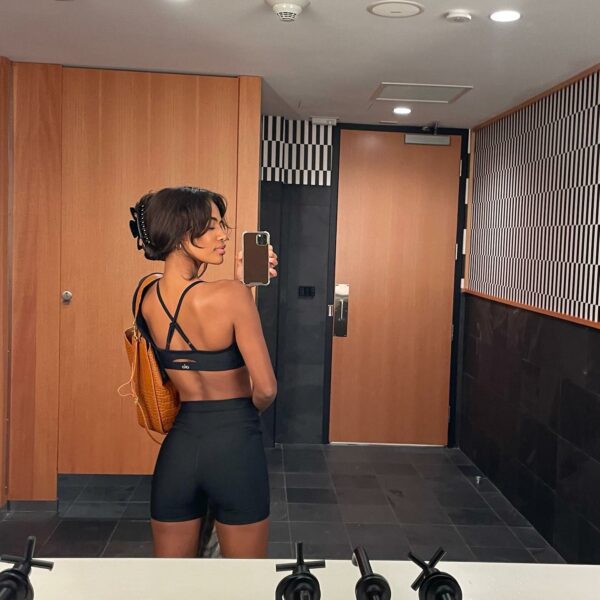
Kourtney Kardashian Barker
You know we are all about that Pilates life here at Poosh, but recently our wellness editor tried out heart-rate-zone training and she won’t. Stop. Talking. About. It. So we decided to dive into exactly what heart-rate-zone training is, and the benefits. To help, we called upon Summer Sides, MS, an exercise scientist for Orangetheory Fitness (OTF), known for its science-backed heart-rate-zone workouts.
What is heart-rate-zone training?
Pretty much what it sounds like: using your heart rate to determine the intensity with which you’re working out. You start by finding your maximum heart rate. A general guideline from the CDC is to subtract your age from 220; it’s not fine-tuned for every individual, but it works well for the majority of us. The American Council on Exercise (ACE) also has this nifty tool that can help you find your general max based on age and fitness level. The “zones” we’re talking about are based on percentages of your max heart rate.
OK, but why? “Heart-rate-zone training allows our members and coaches to have that real-time feedback in each class to push harder or pull back as needed,” Sides says. Ofc, this applies to heart-rate training in general, too, as it allows you to see how hard you’re working and adjust accordingly.
Obvs using a fitness tracker is beneficial here, but if you don’t have one, don’t worry. “For those without a heart-rate monitor, they can still use the theory of zones through a measure of perceived exertion,” Sides says. In addition to the percentage ranges of each zone, we’re also going to explain how each one feels so you can check in with yourself during your workouts.
The 5 Heart Rate Zones
Below, Sides helps break down the differences between zones. (OTF groups each zone by color for its classes, but generally people refer to them by numbers.)
Percentage of max heart rate: 50-60%
What it is: “A very light activity zone—warm-up, cool-down, and active recovery.”
How it feels: “Easy breathing with the ability to easily have a conversation.”
Benefits: “Easy activity or recovery zone that gets the body moving in a light manner.”
Percentage of max heart rate: 61-70%
What it is: “A light activity zone that can be maintained for long periods of time.”
How it feels: “Intensity is still light, with a slight increase in breathing; you feel a little more winded with conversation.”
Benefits: “Endurance training zone that helps the body work out for longer. In this zone, you start to experience more health benefits such as increased cardiovascular fitness, fat loss, and increased blood flow.”
Percentage of max heart rate: 71-83%
What it is: “A moderate intensity that could be maintained for 20-30 minutes.”
How it feels: “More challenging—breathing is heavier; can talk in sentences with labored breathing.”
Benefits: “Fitness zone that improves the body’s overall ability to work out for longer periods of time.”
Percentage of max heart rate: 84-91%
What it is: “A high intensity that can be maintained for only a few minutes.”
How it feels: “Tougher. You can only speak a few words.”
Benefits: “Anaerobic zone that improves speed and strength.”
Percentage of max heart rate: 92-100%
What it is: “A max intensity that can only be maintained for 30-60 seconds.”
How it feels: “Unable to talk.”
Benefits: “Great for individuals looking to improve speed and performance.”
Notice that this is not saying you need to spend tons of time in the high-intensity zones to reap the health benefits. All of the zones are important.
For example: “While there is a specific heart rate zone that will typically burn more fat than others, it’s not necessary to try and target this HR zone to lose weight,” Sides says. “Lower-intensity zones will burn a higher percentage of fat compared to carbs due to how your body breaks down carbs and fat for energy. But higher-intensity training makes the body more efficient and allows you to burn calories at a faster rate.”
TL;DR knowing the different heart-rate zones can help you adjust the intensity of your workout and is also trackable for those of us who like fitness gadgets.
Shop our fitness collection:
The content provided in this article is provided for information purposes only and is not a substitute for professional advice and consultation, including professional medical advice and consultation; it is provided with the understanding that Poosh, LLC (“Poosh”) is not engaged in the provision or rendering of medical advice or services. The opinions and content included in the article are the views of the interviewee only, and Poosh does not endorse or recommend any such content or information, or any product or service mentioned in the article. You understand and agree that Poosh shall not be liable for any claim, loss, or damage arising out of the use of, or reliance upon any content or information in the article.
Up next, be the first to know our weekly content and sign up for our Poosh newsletter.





































